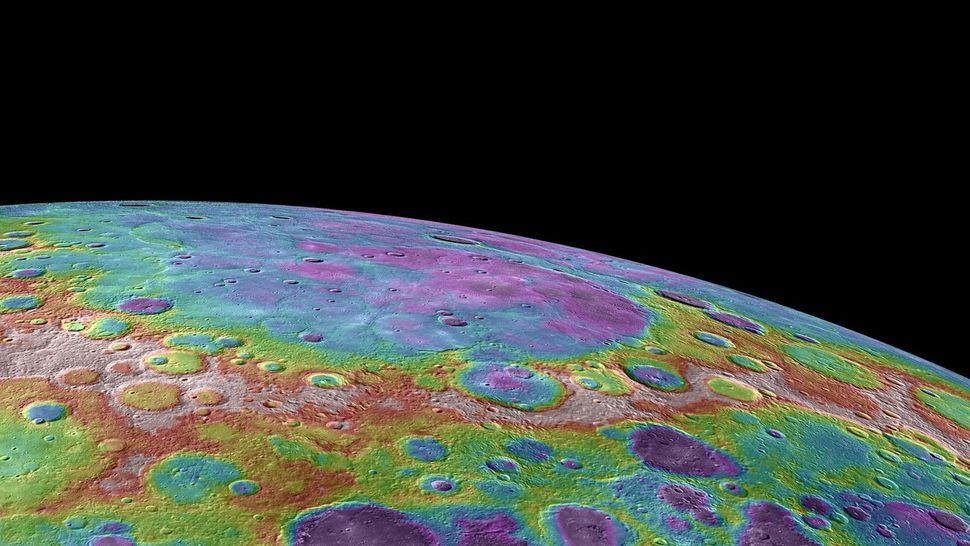Science
Related: About this forum9 miles of solid diamonds may lurk beneath Mercury's surface, new study finds
By Deepa Jain
published 9 hours ago
New simulations suggest that a 9-mile-thick layer of diamonds may lurk deep below the surface of Mercury. The gems almost certainly can't be mined for bling — but they may help solve some of the planet's biggest mysteries.

A rendered photo of Mercury with rainbow colors across its surface
Mercury, seen in this false-color image, may have a deep layer of inner diamonds, new research finds. (Image credit: NASA/Johns Hopkins University Applied Physics Laboratory/Carnegie Institution of Washington)
Mercury may have a thick layer of diamonds hundreds of miles below its surface, a new study shows. The findings, published June 14 in the journal Nature Communications, may help solve mysteries about the planet's composition and peculiar magnetic field.
Mercury is filled with mysteries. For one, it has a magnetic field. Although it's much weaker than Earth's, the magnetism is unexpected because the planet is tiny and appears to be geologically inactive. Mercury also has unusually dark surface patches that NASA's Messenger mission identified as graphite, a form of carbon.
That latter feature is what sparked the curiosity of Yanhao Lin, a staff scientist at the Center for High Pressure Science and Technology Advanced Research in Beijing and co-author of the study. Mercury's extremely high carbon content "made me realize that something special probably happened within its interior," he said in a statement.
Despite Mercury’s oddities, scientists suspect it probably formed the way other terrestrial planets did: from the cooling of a hot magma ocean. In Mercury's case, this ocean was likely rich in carbon and silicate. First, metals coagulated within it, forming a central core, while the remaining magma crystallized into the planet's middle mantle and outer crust.
More:
https://www.livescience.com/space/mercury/9-miles-of-solid-diamonds-may-lurk-beneath-mercurys-surface-new-study-finds
hlthe2b
(107,561 posts)or will they demand private prisons sign over their inmates to mine them on Mars as they did on Earth since the late 1800s?
My cynicism is justified, if hyper-sarcastic.
sl8
(16,284 posts)Diamond has very, very high thermal conductivity.
https://en.m.wikipedia.org/wiki/Material_properties_of_diamond#:~:text=Thermal%20conductivity%20of%20natural%20diamond,the%20most%20thermally%20conductive%20metal.
Thermal conductivity
Unlike most electrical insulators, diamond is a good conductor of heat because of the strong covalent bonding and low phonon scattering. Thermal conductivity of natural diamond was measured to be about 2,200 W/(m·K), which is five times more than silver, the most thermally conductive metal. Monocrystalline synthetic diamond enriched to 99.9% the isotope 12C had the highest thermal conductivity of any known solid at room temperature: 3,320 W/(m·K), though reports exist of superior thermal conductivity in both carbon nanotubes and graphene.[44][45] Because diamond has such high thermal conductance it is already used in semiconductor manufacture to prevent silicon and other semiconducting materials from overheating. At lower temperatures conductivity becomes even better, and reaches 41,000 W/(m·K) at 104 K (−169 °C; −272 °F) (12C-enriched diamond).[45]
Diamond's high thermal conductivity is used by jewelers and gemologists who may employ an electronic thermal probe to distinguish diamonds from their imitations. These probes consist of a pair of battery-powered thermistors mounted in a fine copper tip. One thermistor functions as a heating device while the other measures the temperature of the copper tip: if the stone being tested is a diamond, it will conduct the tip's thermal energy rapidly enough to produce a measurable temperature drop. This test takes about 2–3 seconds. However, older probes will be fooled by moissanite, a crystalline mineral form of silicon carbide introduced in 1998 as an alternative to diamonds, which has a similar thermal conductivity.[8][31]
Technologically, the high thermal conductivity of diamond is used for the efficient heat removal in high-end power electronics. Diamond is especially appealing in situations where electrical conductivity of the heat sinking material cannot be tolerated e.g. for the thermal management of high-power radio-frequency (RF) microcoils that are used to produce strong and local RF fields.[46]
[...]
eppur_se_muova
(38,032 posts)You'd think someone would try silicon carbide, since it's almost as good and much cheaper.